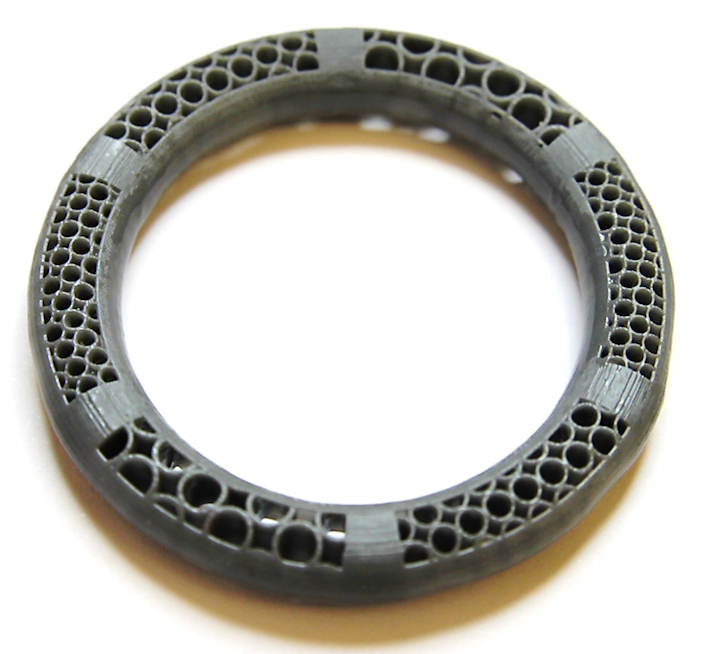Rahima Benhabbour is a woman on an amazing mission. Not only is she a professor at the Eshelman School of Pharmacy University department in Chapel Hill, North Carolina she’s also founder of AnnelleO, a 3D printed intravaginal ring.
Benhabbour’s invention could have a major impact in helping women with a multitude of health issues from trying to get pregnant or avoiding pregnancy to the prevention of HIV and other STIs.
AnnelleO would also be impossible to create without 3D printing. All3DP spoke to Benhabbour to find out more about how exactly she’s creating the rings and the inspiration behind her work:
All3DP: What is AnelleO?
Rahima Benhabbour: AnelleO is a 3D printed intravaginal ring and a platform technology for women’s health indications. To give a bit of background on the name, AnelleO means ring in Italian and the way we market it is, An and a dot then the word “elle” which is her in French then the O becomes the 3D printed ring, so “a ring for her”(An.elle.O).
Currently, AnelleO is focusing on developing a once a month progesterone releasing ring for infertility and assisted reproductive technology or ART. This product would be called AnelleO PRO.

What is the inspiration behind AnelleO?
I had worked for years on developing novel vaginal rings for HIV prevention. I was mainly working with EVA (ethylene vinyl acetate) based rings.
The inspiration came from when I was watching a Ted Talk by Joe DeSimone, who is the CEO of Carbon, the company that owns the CLIP™ technology. While he was giving his Ted Talk, he had a printer on stage that was making a ball with complex geometries at a very fast speed and all that I could think was “oh my gosh, what if you could actually print a ring that has those intricate features in it?”
Now we have so many different avenues to fine tune and control the diffusion of drugs from the ring as opposed to just having a solid ring where drug diffusion is very limited in terms of control.
Currently, the IVR is a one-size-fits-all. We know that women have different anatomies, from being young and adolescent to women who have had multiple children and are towards their thirties or forties. There is definitely a difference in anatomy and having only a one-size-fits-all is not really realistic or fair for women.
Why did you choose to begin with a progesterone ring?
The reason why we chose AnelleO PRO, a progesterone-releasing ring, as our first indication is because there is definitely a need in the US for a once-a-month treatment that can provide the same levels of progesterone as a supplementation for promoting pregnancy and maintaining it.
Currently, the marketed products for ART are limited to vaginal gels or inserts that have to be administered two or three times a day and they’re messy and unpleasant. Or, an injection which is painful and has to be administered daily by a partner. So, really there is no treatment out there that can provide supplementation of progesterone in a sustained fashion. This is where our once a month delivery of progesterone comes in to solve that need.
Who do you hope will benefit from AnelleO?
My heart has always been for the philanthropic side of it, so the non-profit side, and that’s where my passion is still and will always be. My hope is that it would help women in first-world countries to provide a better treatment, but the bigger goal for me personally is to see it help the women that are in most need in Sub-Saharan Africa, South East Asia, and South America, really, but mostly Sub-Saharan Africa where the prevalence of HIV is the highest and where women do not have any means in which they can protect themselves in a female-controlled fashion that is discreet, cost-effective and accessible. For me, if we could make that happen it would be a dream come true.

What stage of development is AnelleO Pro in now? When are you hoping to bring it to market?
AnelleO has received funding from the Kickstart program at UNC to carry out pre-clinical studies. We’ve done quite a few of them and have shown we can actually release progesterone over 30 days in an ordered or sustained fashion.
We can finetune the release of progesterone by changing the design or material that we’re using and the way we put progesterone in the ring.
We’re still at the pre-clinical and development (R&D) stage, we have another one or two years of pre-clinical before we can file an Investigational New Drug application.
At this stage, AnelleO is a start-up. Because of the nature of the product, we’re going to need the facilities to produce these rings meaning we’ll have to partner with a pharmaceutical company to do all that. It’s a long road, but fun and exciting road to say the least.
How is AnelleO made and what materials do you use?
We have a collaboration with Carbon to use CLIP for the AnelleO 3D printed ring. The current biocompatible resin that we’re using is a silosiloxane-polyurethaneed material which is a Carbon resin.
What are the benefits of using 3D printing for creating AnelleO?
The major benefits are control of drug release kinetics. With injection molded rings, because the design of the ring is limited and because drug release happens by diffusion of the drug from the ring, this leads to over 80% of the drug that’s loaded in the ring not being released within the time frame of the use of the ring. We are able to release 100% of the drug that we are loading in the ring.
Injection molded rings are one size fits. It takes weeks to generate a mold with a different cross-sectional diameter and costs ~$50,000 or more. But, we’re using computer-aided-design (CAD) which takes a few sections to change dimensions from one size to another and we can then use the new CAD to print a ring in a matter of minutes.
When many women see the rings that are currently being developed for HIV prevention, some of the first reactions are “wow, this is too big” and they’re worried about the ring changing their anatomy or “this ring looks too medicinal”. If we can make a ring in different sizes that actually appeal to these women so they’ll want to use it – making it look better by designing it to look less medicinal and more comfortable, I think that would make a huge difference.
The other aspects are accessibility and cost. Current technologies that aspire to produce rings with drugs for HIV prevention and contraception still rely on injection molding and involve multi-step and complex engineering and not really cost-effective.
So, if we can make these rings in a single step and cost-effective process and accessible to the people who need them the most this could make a major impact in the prevention of HIV (STIs) and unintended pregnancy.

Website: LINK

